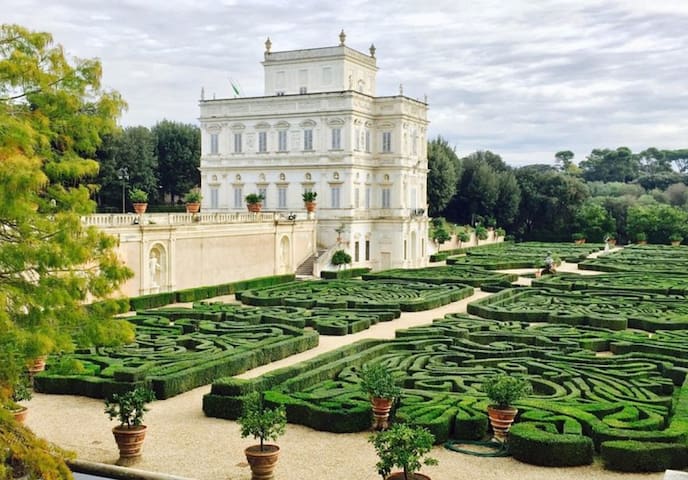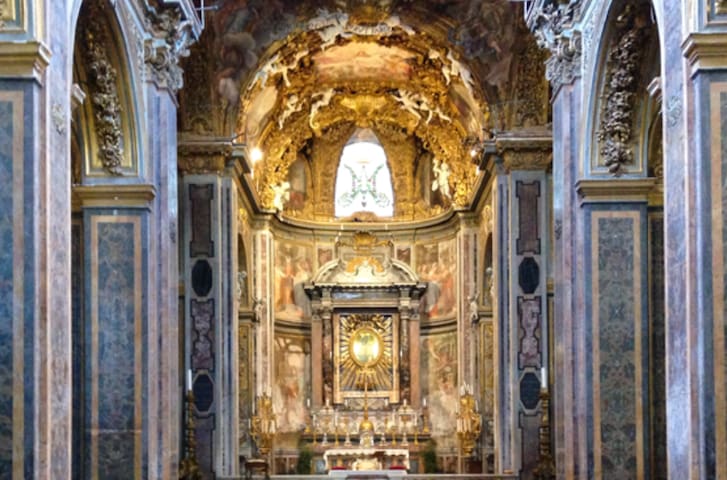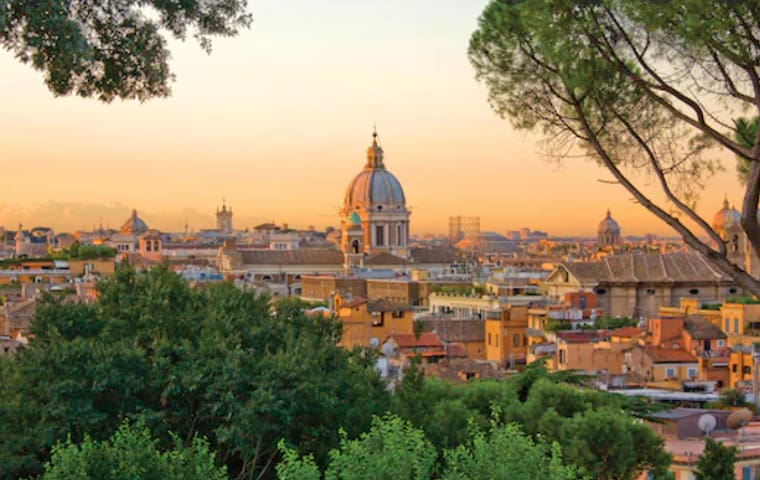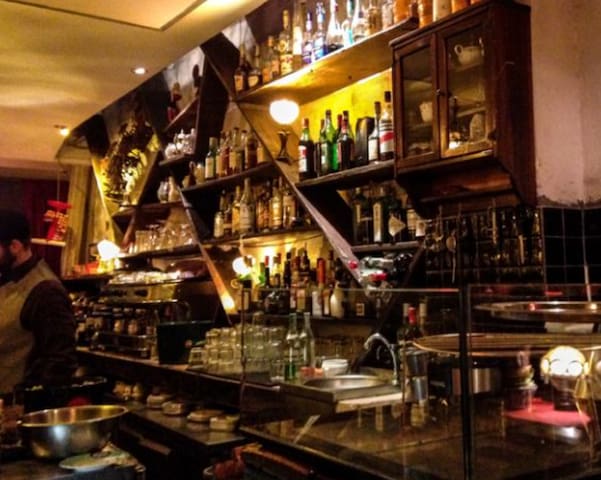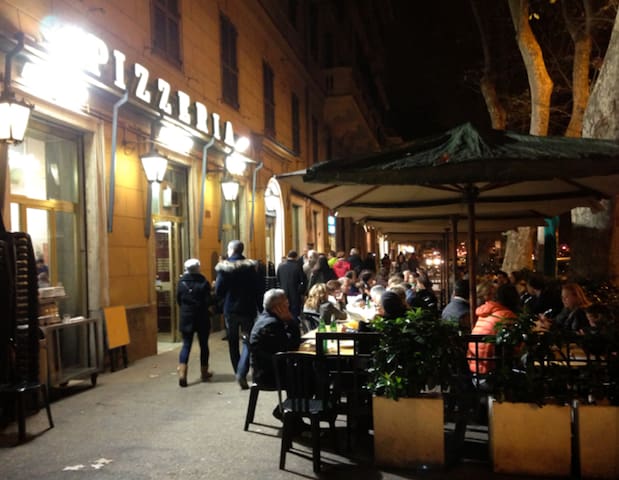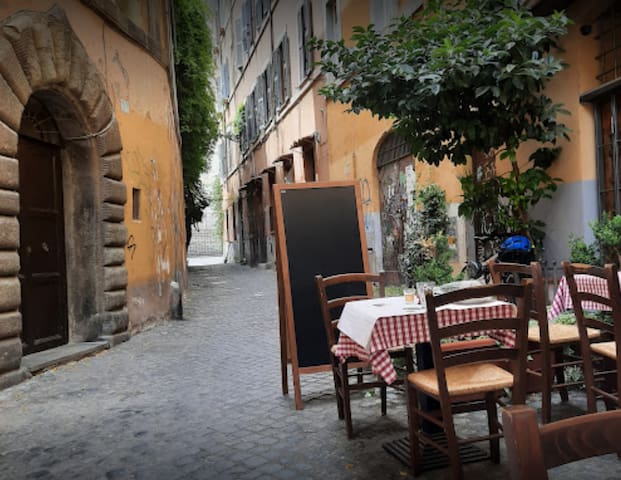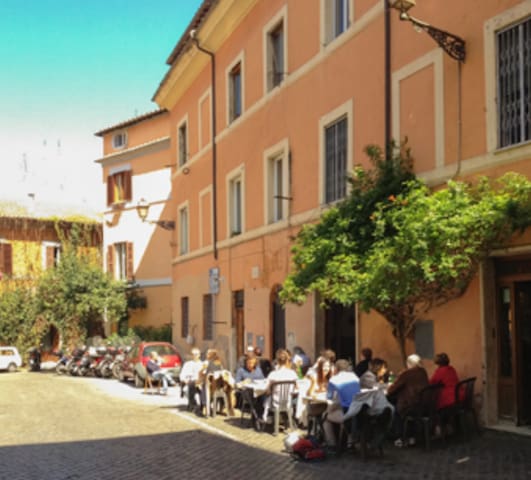Sightseeing
Ancient heart of the Trastevere district, Piazza di Santa Maria in Trastevere is dominated by the Basilica from which it takes its name. Considered the oldest in Rome, the Basilica was built in the same place where a fountain was at the time of Emperor Augustus.
On the side, adjacent to the Basilica, is the seventeenth-century Palazzo San Callisto owned by the Holy See.
In the middle of the square is one of the oldest among the monumental fountains of Rome, already documented in the plan by Pietro del Massaio (1471) with a shape substantially similar to the one visible today: a polygonal basin in the center of which two overlapping basins rise (later reduced to one ).
384 ντόπιοι το προτείνουν
Βασιλική της Παναγίας στο Τραστεβέρε
Piazza di Santa Maria in TrastevereAncient heart of the Trastevere district, Piazza di Santa Maria in Trastevere is dominated by the Basilica from which it takes its name. Considered the oldest in Rome, the Basilica was built in the same place where a fountain was at the time of Emperor Augustus.
On the side, adjacent to the Basilica, is the seventeenth-century Palazzo San Callisto owned by the Holy See.
In the middle of the square is one of the oldest among the monumental fountains of Rome, already documented in the plan by Pietro del Massaio (1471) with a shape substantially similar to the one visible today: a polygonal basin in the center of which two overlapping basins rise (later reduced to one ).
In the heart of Rome between Via della Lungara and the Gianicolo Hill, you can find a magical place where to walk away from the chaos of the city, and enjoy the spectacle represented by the extraordinary variety of the plant world preserved here.
Among the largest in Italy, the Botanical Garden of Rome is located in the park of Villa Corsini, once the residence of Christine of Sweden, and on part of the Horti Getae, archaeological area formerly constituted by the Baths of Septimius Severus.
The Botanical Garden is fully part of the tradition of gardens with an important scientific and naturalistic value, such as that of the Vatican, first example of a botanical garden.
278 ντόπιοι το προτείνουν
Βοτανικός Κήπος της Ρώμης
23 A - 24 Largo Cristina di SveziaIn the heart of Rome between Via della Lungara and the Gianicolo Hill, you can find a magical place where to walk away from the chaos of the city, and enjoy the spectacle represented by the extraordinary variety of the plant world preserved here.
Among the largest in Italy, the Botanical Garden of Rome is located in the park of Villa Corsini, once the residence of Christine of Sweden, and on part of the Horti Getae, archaeological area formerly constituted by the Baths of Septimius Severus.
The Botanical Garden is fully part of the tradition of gardens with an important scientific and naturalistic value, such as that of the Vatican, first example of a botanical garden.
We are not inside Trastevere actually, but this park is so large and beautiful that I can't resist adding it to the website. In fact, it's easy reachable on foot: starting from Via Garibaldi a 10-minute steep walk will lead you to the main park's entrance, in Via di Porta S. Pancrazio.
Villa Pamphilj is the largest park in Rome. It used to be property of the Roman noble Pamphilj family and it still retains many buildings, fountains and sculptures of historical and artistic interest. Its history begins in far 1630 when Giovanni Battista Pamphilj was appointed cardinal and his brother bought a farm close to the arches of the ancient Trajan's aqueduct.
67 ντόπιοι το προτείνουν
Βίλα Πάμφιλη
183 Via Aurelia AnticaWe are not inside Trastevere actually, but this park is so large and beautiful that I can't resist adding it to the website. In fact, it's easy reachable on foot: starting from Via Garibaldi a 10-minute steep walk will lead you to the main park's entrance, in Via di Porta S. Pancrazio.
Villa Pamphilj is the largest park in Rome. It used to be property of the Roman noble Pamphilj family and it still retains many buildings, fountains and sculptures of historical and artistic interest. Its history begins in far 1630 when Giovanni Battista Pamphilj was appointed cardinal and his brother bought a farm close to the arches of the ancient Trajan's aqueduct.
The church of Santa Maria dell'Orto owes its name ("orto" means vegetable garden) to its location, an area that was covered by vegetable gardens up to the end of the 15th century. According to the legend, a miracle was attributed to an image of the Virgin Mary painted on one of the border walls of a vegetable garden. The owner of this garden happened to be very sick and nothing could heal him. He prayed fervently the Madonna to intercede for him and when he fully recovered he ordered the building of a chapel dedicated to her as a sign of gratitude. A small group of faithful people soon gathered to worship the sacred image and eventually decided to call themselves the Compagnia della Madonna Santissima dell’Orto. In 1492 the Compagnia became a confraternity approved by pope Alexander VI. Almost one hundred years later, in 1588, it was elevated into an arch-confraternity aggregating several confraternities and was able to start the building of its own church.
Chiesa di Santa Maria dell’Orto
10 Via AniciaThe church of Santa Maria dell'Orto owes its name ("orto" means vegetable garden) to its location, an area that was covered by vegetable gardens up to the end of the 15th century. According to the legend, a miracle was attributed to an image of the Virgin Mary painted on one of the border walls of a vegetable garden. The owner of this garden happened to be very sick and nothing could heal him. He prayed fervently the Madonna to intercede for him and when he fully recovered he ordered the building of a chapel dedicated to her as a sign of gratitude. A small group of faithful people soon gathered to worship the sacred image and eventually decided to call themselves the Compagnia della Madonna Santissima dell’Orto. In 1492 the Compagnia became a confraternity approved by pope Alexander VI. Almost one hundred years later, in 1588, it was elevated into an arch-confraternity aggregating several confraternities and was able to start the building of its own church.
This magnificent church is located on the quiter side of Trastevere, where the echoes of past ages still sound.
History and legend are necessarily interwoven when the events are so far in the past. It is said that here was the house of Cecilia, a patrician Roman lady converted to Christianity when it was deemed illegal. She donated all her belongings to the Christian community and was cruelty martyrized under the reign of Alexander Severus. First scalded and then beheaded.
The crypt excavations reveal a large and complex structure: Part of the building was possibly used as a warehouse or a tannery in the Republican era. This area surrounding the Tiber was indeed a commercial hub, the river banks crowded with ships bringing all kinds of commodities from the provinces conquered by the Romans. It soon became home to workers and immigrants (the Jews community was the largest).
72 ντόπιοι το προτείνουν
Σάντα Τσετσίλια στο Τραστεβέρε
22 Piazza di Santa CeciliaThis magnificent church is located on the quiter side of Trastevere, where the echoes of past ages still sound.
History and legend are necessarily interwoven when the events are so far in the past. It is said that here was the house of Cecilia, a patrician Roman lady converted to Christianity when it was deemed illegal. She donated all her belongings to the Christian community and was cruelty martyrized under the reign of Alexander Severus. First scalded and then beheaded.
The crypt excavations reveal a large and complex structure: Part of the building was possibly used as a warehouse or a tannery in the Republican era. This area surrounding the Tiber was indeed a commercial hub, the river banks crowded with ships bringing all kinds of commodities from the provinces conquered by the Romans. It soon became home to workers and immigrants (the Jews community was the largest).
The church of Sant'Onofrio on the Janiculum hill, at the northern end of Trastevere, is one of the few examples of Renaissance architecture existing in Rome. In fact, the church is dedicated to St. Onofrio, a a 4th century Egyptian hermit or Desert Father, but was founded in 1439 by the blessed Nicolò da Forca Palena. As leader of a small religious congregation, Nicolò chose this isolated site to establish a hermitage in 1419 and with time and the faithful's donations he was able to build a proper monastery with a church. Although the site was not easy to get to - with just a steep footpath running up the hill - many people used to visit the founder's tomb as he had been well known for curing diseases. He himself died at the age of 100! Today you can still see his gravestone walled in the portico.
10 ντόπιοι το προτείνουν
Chiesa di Sant'Onofrio al Gianicolo
2 Piazza di Sant'OnofrioThe church of Sant'Onofrio on the Janiculum hill, at the northern end of Trastevere, is one of the few examples of Renaissance architecture existing in Rome. In fact, the church is dedicated to St. Onofrio, a a 4th century Egyptian hermit or Desert Father, but was founded in 1439 by the blessed Nicolò da Forca Palena. As leader of a small religious congregation, Nicolò chose this isolated site to establish a hermitage in 1419 and with time and the faithful's donations he was able to build a proper monastery with a church. Although the site was not easy to get to - with just a steep footpath running up the hill - many people used to visit the founder's tomb as he had been well known for curing diseases. He himself died at the age of 100! Today you can still see his gravestone walled in the portico.
The church of St Chrysogonus, one of the oldest churches in Rome, is often overlooked by visitors but it is surprisingly beautiful, a perfect example of how different periods have left their traces over the centuries. Let's begin the visit looking at the exterior: a bright 17th-century facade has been added to a medieval structure. The bell-tower dates from the 12th century. It was modified with the addition of a pyramidal spire, as in the basilica of Santa Maria Maggiore. In the 18th century, Cardinal Scipione Borghese, a powerful patron of the arts, commissioned the architect Giovan Battista Soria to undertake a major renovation and had his name written over the facade.
Entering the church, you are immediately struck by the quiet and dark medieval atmosphere, the traffic noise is left behind. Be careful, you are walking over one of the most beautiful and well-preserved 13th-century mosaic floors in Rome. During the Middle Ages, a family of artists, called Cosmati made a great number of decorations out of the remains of ancient Roman colored marbles. These geometric patterns also had a practical purpose: they divided and mapped the floor into specific areas which facilitated processions on feast days.
9 ντόπιοι το προτείνουν
Βασιλική του Αγίου Χρυσογόνου
44 Piazza Sidney SonninoThe church of St Chrysogonus, one of the oldest churches in Rome, is often overlooked by visitors but it is surprisingly beautiful, a perfect example of how different periods have left their traces over the centuries. Let's begin the visit looking at the exterior: a bright 17th-century facade has been added to a medieval structure. The bell-tower dates from the 12th century. It was modified with the addition of a pyramidal spire, as in the basilica of Santa Maria Maggiore. In the 18th century, Cardinal Scipione Borghese, a powerful patron of the arts, commissioned the architect Giovan Battista Soria to undertake a major renovation and had his name written over the facade.
Entering the church, you are immediately struck by the quiet and dark medieval atmosphere, the traffic noise is left behind. Be careful, you are walking over one of the most beautiful and well-preserved 13th-century mosaic floors in Rome. During the Middle Ages, a family of artists, called Cosmati made a great number of decorations out of the remains of ancient Roman colored marbles. These geometric patterns also had a practical purpose: they divided and mapped the floor into specific areas which facilitated processions on feast days.
The Janiculum is a Roman hill, overlooking the right bank of the Tiber, whose maximum height is 88 meters, not included in the group of seven traditional hills. The eastern slope slopes down towards the river and at the base is the historic district of Trastevere, while the western one, less steep, is the oldest part of the modern district of Monteverde; to the south-west of the hill is Villa Doria Pamphili, while on its eastern slopes are the botanical gardens of Rome and the Regina Coeli priso. Perfect place to look over and take pictures of all the churches and buildings of Rome below.
363 ντόπιοι το προτείνουν
Ταράτσα του Γιανικούλουμ
Salita di Sant'OnofrioThe Janiculum is a Roman hill, overlooking the right bank of the Tiber, whose maximum height is 88 meters, not included in the group of seven traditional hills. The eastern slope slopes down towards the river and at the base is the historic district of Trastevere, while the western one, less steep, is the oldest part of the modern district of Monteverde; to the south-west of the hill is Villa Doria Pamphili, while on its eastern slopes are the botanical gardens of Rome and the Regina Coeli priso. Perfect place to look over and take pictures of all the churches and buildings of Rome below.
Bars&Nighlife
A decades-old Trastevere institution, bar San Calisto - as distinct from most venues in Rome - has never been renovated and sticks to its basic décor and cheap prices. It's open from early morning to late at night, and attracts people of any age and social standing - artists and intellectuals, alcoholics and idlers, housewives and American students.
164 ντόπιοι το προτείνουν
Bar San Calisto
3 Piazza di S. CalistoA decades-old Trastevere institution, bar San Calisto - as distinct from most venues in Rome - has never been renovated and sticks to its basic décor and cheap prices. It's open from early morning to late at night, and attracts people of any age and social standing - artists and intellectuals, alcoholics and idlers, housewives and American students.
Far from the typical chaos and noise of many Trastevere streets, Big Star is a not touristy combination cafe-bar, pub and music venue which takes its name from an influential rock band. And, indeed, music is what inspires everything inside this bi-level place, from decor to staff and clientele.
Big Star is quite popular with young people, but whatever your age, its easygoing atmosphere makes you feel at ease whether you are on your own or with friends.
It opens early in the morning and offers the classical Roman breakfast with cappuccino and cornetto (or fresh home-made cakes) as well as continental breakfast. You can take a seat at the long wooden bar or choose a table and read the newspapers while sipping your coffee. During the daytime the place is quiet. Both the furniture and the relaxed atmosphere encourage people to mingle and socialize. One side of the locale is wallpapered with LP album covers and has a large communal table. Someone clacks on his laptop while others sit on the comfortable sofa and play checks. The regular clientele is friendly and mostly local: small groups of friends and young families with kids. Dogs are allowed inside. The place has a lot of seating inside and outside and on weekend evenings starts to get crowded with mostly 30-something. From Thursday to Sunday a rich buffet is offered with the evening aperitif. You may have rice or cereal salads, veg pies, bruschetta and much more, all included in your dink's price. On weekday evenings, the drinks are accompanied by a bowl of chips or peanuts. It can get pretty loud at times but the atmosphere is cozy and intimate all the same.
At Big Star they favor local craft breweries. They have also a small yet good selection of organic white and red wines served by the glass. The staff is always friendly and ready to explain the different kind of beers to you. On warm summer nights everybody swarm outside for a drink o a light dinner. The tables here can seat about 30 people but a lot more stand around on the large sidewalk drinking beer and chatting with friends.
Big Star is also a great venue for live-music lovers. If you happen to be there on a Saturday night, go upstairs and join the affectionate fans of some rock band playing on the stage. The concerts are free, no entrance charge. On a recent Saturday night I enjoyed a nice American Folk music trio and bought one of their CDs, too.
In addition to live music, Big Star hosts documentary series about rock bands and their concerts. You can find all information on their Facebook events page.
43 ντόπιοι το προτείνουν
Big Star Bar Diner
25 Via Goffredo MameliFar from the typical chaos and noise of many Trastevere streets, Big Star is a not touristy combination cafe-bar, pub and music venue which takes its name from an influential rock band. And, indeed, music is what inspires everything inside this bi-level place, from decor to staff and clientele.
Big Star is quite popular with young people, but whatever your age, its easygoing atmosphere makes you feel at ease whether you are on your own or with friends.
It opens early in the morning and offers the classical Roman breakfast with cappuccino and cornetto (or fresh home-made cakes) as well as continental breakfast. You can take a seat at the long wooden bar or choose a table and read the newspapers while sipping your coffee. During the daytime the place is quiet. Both the furniture and the relaxed atmosphere encourage people to mingle and socialize. One side of the locale is wallpapered with LP album covers and has a large communal table. Someone clacks on his laptop while others sit on the comfortable sofa and play checks. The regular clientele is friendly and mostly local: small groups of friends and young families with kids. Dogs are allowed inside. The place has a lot of seating inside and outside and on weekend evenings starts to get crowded with mostly 30-something. From Thursday to Sunday a rich buffet is offered with the evening aperitif. You may have rice or cereal salads, veg pies, bruschetta and much more, all included in your dink's price. On weekday evenings, the drinks are accompanied by a bowl of chips or peanuts. It can get pretty loud at times but the atmosphere is cozy and intimate all the same.
At Big Star they favor local craft breweries. They have also a small yet good selection of organic white and red wines served by the glass. The staff is always friendly and ready to explain the different kind of beers to you. On warm summer nights everybody swarm outside for a drink o a light dinner. The tables here can seat about 30 people but a lot more stand around on the large sidewalk drinking beer and chatting with friends.
Big Star is also a great venue for live-music lovers. If you happen to be there on a Saturday night, go upstairs and join the affectionate fans of some rock band playing on the stage. The concerts are free, no entrance charge. On a recent Saturday night I enjoyed a nice American Folk music trio and bought one of their CDs, too.
In addition to live music, Big Star hosts documentary series about rock bands and their concerts. You can find all information on their Facebook events page.
Akbar has been the first cafè-restaurant in Trastevere entirely furnished with vintage pieces, each one different from the other, setting the trend in the neighborhood. A small group of young people opened the Akbar a few years ago at the corner between Piazza in Piscinula and Via della Lungaretta, a charming area of Trastevere close to the Tiber Island. The distinctive feature of the place is definitely its furniture and the atmosphere inside: they make you feel as if you were entering somebody's very stylish private home! Small round or square tables, a larger one, chairs and armchairs in different shapes and style, a comfortable sofa, vintage lamps and cozy and creative touches everywhere. The ambiance and the background music make Akbar the ideal place for a rather young clientele. A lot of locals, 30- and 40-something mingle with tourists, at any time of the day.
Take a coffee-break on a sunny morning sitting outside on an ancient Corinthian capital or a tea in the afternoon served in mismatched china. You can stop here for a pre-dinner a glass of wine and decide to stay for dinner.
On a recent spring evening with three of my friends we had a small portion of melanzane parmigiana, a soufflé with spinach and cheese and a selection of cheese and salumi for starters. Then, for a change we didn't choose the typical Roman recipes but strangozzi (home-made pasta from Umbria) with artichokes and pancetta (crispy, salty bites of bacon) and pici (spaghetti-like home-made pasta) with meat and tomato sauce.
Well, it's not a menu for vegetarians! It proposes different recipes with beef, as for example slow-cooked ox cheek served with potato purée and big hamburgers with bacon, cheese and tomatoes or with onions and chips.
The wine list is rather small but they have also beers. Every Sunday from 12 am to 5 pm is brunch time at Akbar. A rich buffet of dishes from Rome and Tuscany and a selection of cakes are offered at a fixed price. Sunday night is also the ideal time to go if you love listening to live music performed by rock and blues bands or enjoying a DJ set going on till late in the night.
6 ντόπιοι το προτείνουν
Piazza in Piscinula
Akbar has been the first cafè-restaurant in Trastevere entirely furnished with vintage pieces, each one different from the other, setting the trend in the neighborhood. A small group of young people opened the Akbar a few years ago at the corner between Piazza in Piscinula and Via della Lungaretta, a charming area of Trastevere close to the Tiber Island. The distinctive feature of the place is definitely its furniture and the atmosphere inside: they make you feel as if you were entering somebody's very stylish private home! Small round or square tables, a larger one, chairs and armchairs in different shapes and style, a comfortable sofa, vintage lamps and cozy and creative touches everywhere. The ambiance and the background music make Akbar the ideal place for a rather young clientele. A lot of locals, 30- and 40-something mingle with tourists, at any time of the day.
Take a coffee-break on a sunny morning sitting outside on an ancient Corinthian capital or a tea in the afternoon served in mismatched china. You can stop here for a pre-dinner a glass of wine and decide to stay for dinner.
On a recent spring evening with three of my friends we had a small portion of melanzane parmigiana, a soufflé with spinach and cheese and a selection of cheese and salumi for starters. Then, for a change we didn't choose the typical Roman recipes but strangozzi (home-made pasta from Umbria) with artichokes and pancetta (crispy, salty bites of bacon) and pici (spaghetti-like home-made pasta) with meat and tomato sauce.
Well, it's not a menu for vegetarians! It proposes different recipes with beef, as for example slow-cooked ox cheek served with potato purée and big hamburgers with bacon, cheese and tomatoes or with onions and chips.
The wine list is rather small but they have also beers. Every Sunday from 12 am to 5 pm is brunch time at Akbar. A rich buffet of dishes from Rome and Tuscany and a selection of cakes are offered at a fixed price. Sunday night is also the ideal time to go if you love listening to live music performed by rock and blues bands or enjoying a DJ set going on till late in the night.
Food scene
Best known by Romans as the Obitorio (Morgue) because of its long marble tables and fluorescent lights, this pizzeria makes for a gastronomic and cultural experience.
Reservations are not accepted, and each night after 7.30/8.00 PM the two rooms and the tables outside are full, so get there early or you'll have to wait for a table. Yet the line moves fast, and once you are seated don't expect to have any privacy, as there is no space between tables, and you'll find yourself elbow rubbing with the Italian mega families, and this is part of the fun. Actually, this is a rather noisy place, where tourists are outnumbered by Romans, and you have to talk loudly if you want to be heard!
You'll get no tablecloths, the speedy waiters will bring you only glasses, cutlery and paper napkins, but the food here is really tasty and inexpensive. As starters, you may have a great choice of typical fried dishes as supplì, zucchini blossoms with mozzarella and anchovies, mackerel fillets and olive ascolane ( fried big olives filled with meat).
The staff at the large wood-fired oven prepare and deliver pizze non-stop. It's the very thin Roman kind of pizza, with a great variety of fresh and tasty toppings.
Another specialties of Ai Marmi are its home made desserts, among which the tiramisù is the best!
For drinking, you can ask a bottle of beer or the red or white wine of the house.
215 ντόπιοι το προτείνουν
Ai Marmi
53-59 Viale di TrastevereBest known by Romans as the Obitorio (Morgue) because of its long marble tables and fluorescent lights, this pizzeria makes for a gastronomic and cultural experience.
Reservations are not accepted, and each night after 7.30/8.00 PM the two rooms and the tables outside are full, so get there early or you'll have to wait for a table. Yet the line moves fast, and once you are seated don't expect to have any privacy, as there is no space between tables, and you'll find yourself elbow rubbing with the Italian mega families, and this is part of the fun. Actually, this is a rather noisy place, where tourists are outnumbered by Romans, and you have to talk loudly if you want to be heard!
You'll get no tablecloths, the speedy waiters will bring you only glasses, cutlery and paper napkins, but the food here is really tasty and inexpensive. As starters, you may have a great choice of typical fried dishes as supplì, zucchini blossoms with mozzarella and anchovies, mackerel fillets and olive ascolane ( fried big olives filled with meat).
The staff at the large wood-fired oven prepare and deliver pizze non-stop. It's the very thin Roman kind of pizza, with a great variety of fresh and tasty toppings.
Another specialties of Ai Marmi are its home made desserts, among which the tiramisù is the best!
For drinking, you can ask a bottle of beer or the red or white wine of the house.
Pizzeria Dar Poeta, in a small street off the happening Trastevere neighborhood, Dar Poeta specializes in a 100% natural and yeast-free slow-rise pizza, which is exceptionally digestible. The toppings are traditional, as well as eclectic, like apple and Grand Marnier. The service can verge on gruff, in the best Roman fashion, and the bill's scrawled on the brown-paper covering the table. But the atmosphere's jolly, even in long queues outside (no reservations). Dine-in · Takeaway · Delivery
217 ντόπιοι το προτείνουν
Dar Poeta
45 Vicolo del BolognaPizzeria Dar Poeta, in a small street off the happening Trastevere neighborhood, Dar Poeta specializes in a 100% natural and yeast-free slow-rise pizza, which is exceptionally digestible. The toppings are traditional, as well as eclectic, like apple and Grand Marnier. The service can verge on gruff, in the best Roman fashion, and the bill's scrawled on the brown-paper covering the table. But the atmosphere's jolly, even in long queues outside (no reservations). Dine-in · Takeaway · Delivery
The restaurant Cencio la Parolaccia (Cencio's Profanities) is a restaurant in the Trastevere rione of Rome. It is mostly famous for the behaviour of its waiters, who curse at or otherwise verbally abuse the diners, including tourists. Traditional roman food!
21 ντόπιοι το προτείνουν
Cencio la Parolaccia
3 Vicolo del CinqueThe restaurant Cencio la Parolaccia (Cencio's Profanities) is a restaurant in the Trastevere rione of Rome. It is mostly famous for the behaviour of its waiters, who curse at or otherwise verbally abuse the diners, including tourists. Traditional roman food!
Most people visiting Rome would like to eat not where tourists go but where Romans go to eat. Here in Trastevere the osteria Zì Mberto, one of the liveliest and much loved restaurants, can meet their wish. Very popular with locals, it's so crowded at lunch and dinner that you may have to share a table with someone else! This trattoria is open both for lunch and dinner. When possible reserve a table in advance, but if you can't do it and decide to show up at the door, don't expect a waiter welcoming you and offering a good table because it doesn't work this way by Zì Mberto: you have to introduce yourself and be aware of those Italians who pretend to ignore the queue!
In fact sometimes the service may be rather brusque, as is typical of Roman osterie with Italian regulars. Yet Paolo, a longtime connoisseur of Roman nightlife, knows many of his customers and at least once a year he gathers all his friends for a cheerful party at his restaurant!
55 ντόπιοι το προτείνουν
Osteria da Zi Umberto
14 Piazza di S. Giovanni della MalvaMost people visiting Rome would like to eat not where tourists go but where Romans go to eat. Here in Trastevere the osteria Zì Mberto, one of the liveliest and much loved restaurants, can meet their wish. Very popular with locals, it's so crowded at lunch and dinner that you may have to share a table with someone else! This trattoria is open both for lunch and dinner. When possible reserve a table in advance, but if you can't do it and decide to show up at the door, don't expect a waiter welcoming you and offering a good table because it doesn't work this way by Zì Mberto: you have to introduce yourself and be aware of those Italians who pretend to ignore the queue!
In fact sometimes the service may be rather brusque, as is typical of Roman osterie with Italian regulars. Yet Paolo, a longtime connoisseur of Roman nightlife, knows many of his customers and at least once a year he gathers all his friends for a cheerful party at his restaurant!
One of my favorite places to go and eat a simple but tasty meal is the trattoria "da Augusto", a very popular trattoria, where locals and tourists mingle at lunch and dinner. Now it's run by Sandro, Augusto's son, but it never followed the latest fashion and still maintains the same furniture and style of the beginnings.
It is loved by young people and by old Trastevere families too. Some of them meet there every day, ask for their quartino (a small measure) of red or white wine and start chatting about politics, soccer or relatives. As in many trattorie in this neighborhood, tables are very close to each other, and it's not the best place if you looking for a quiet, intimate rendezvous!
In winter days, people would fill the two small rooms inside, but as soon as the weather is fine enough, a number of wooden tables with paper cloths are added outside, on the nice and quiet Piazza de' Renzi.
I would say that by "Augusto" the old Roman culinary tradition is well respected, so that every day of the week has its special dish: fish on Tuesdays and Fridays, gnocchi on Thursdays and trippa on Saturdays. The service is rather brisk but friendly, with young waiters delivering generous dishes of rigatoni all'amatriciana, alla gricia or carbonara. A crusty, delicious bread can accompany boiled beaf, seppie con piselli, veal involtini or roasted rabbit.
Don't miss a slice of the homemade desserts, either a fruit cake or ricotta and chocolate cake.
It is still one of the less expensive trattorie in Trastevere, as you will see when the waiter writes the bill down on your tablecloth!
I would suggest to go there early in the evening or be prepared to wait outside, as Augusto doesn't take reservations and can boast lots of aficionados!
164 ντόπιοι το προτείνουν
Trattoria da Augusto
15 Vicolo de' RenziOne of my favorite places to go and eat a simple but tasty meal is the trattoria "da Augusto", a very popular trattoria, where locals and tourists mingle at lunch and dinner. Now it's run by Sandro, Augusto's son, but it never followed the latest fashion and still maintains the same furniture and style of the beginnings.
It is loved by young people and by old Trastevere families too. Some of them meet there every day, ask for their quartino (a small measure) of red or white wine and start chatting about politics, soccer or relatives. As in many trattorie in this neighborhood, tables are very close to each other, and it's not the best place if you looking for a quiet, intimate rendezvous!
In winter days, people would fill the two small rooms inside, but as soon as the weather is fine enough, a number of wooden tables with paper cloths are added outside, on the nice and quiet Piazza de' Renzi.
I would say that by "Augusto" the old Roman culinary tradition is well respected, so that every day of the week has its special dish: fish on Tuesdays and Fridays, gnocchi on Thursdays and trippa on Saturdays. The service is rather brisk but friendly, with young waiters delivering generous dishes of rigatoni all'amatriciana, alla gricia or carbonara. A crusty, delicious bread can accompany boiled beaf, seppie con piselli, veal involtini or roasted rabbit.
Don't miss a slice of the homemade desserts, either a fruit cake or ricotta and chocolate cake.
It is still one of the less expensive trattorie in Trastevere, as you will see when the waiter writes the bill down on your tablecloth!
I would suggest to go there early in the evening or be prepared to wait outside, as Augusto doesn't take reservations and can boast lots of aficionados!
Συμβουλές για την πόλη
Μην το χάσετε
www.q-kings.org
Q-KING CLAUS
YOUR KITCHEN BUDDY
FOR A UNIQUE COOKING ADVENTURE IN ROME


